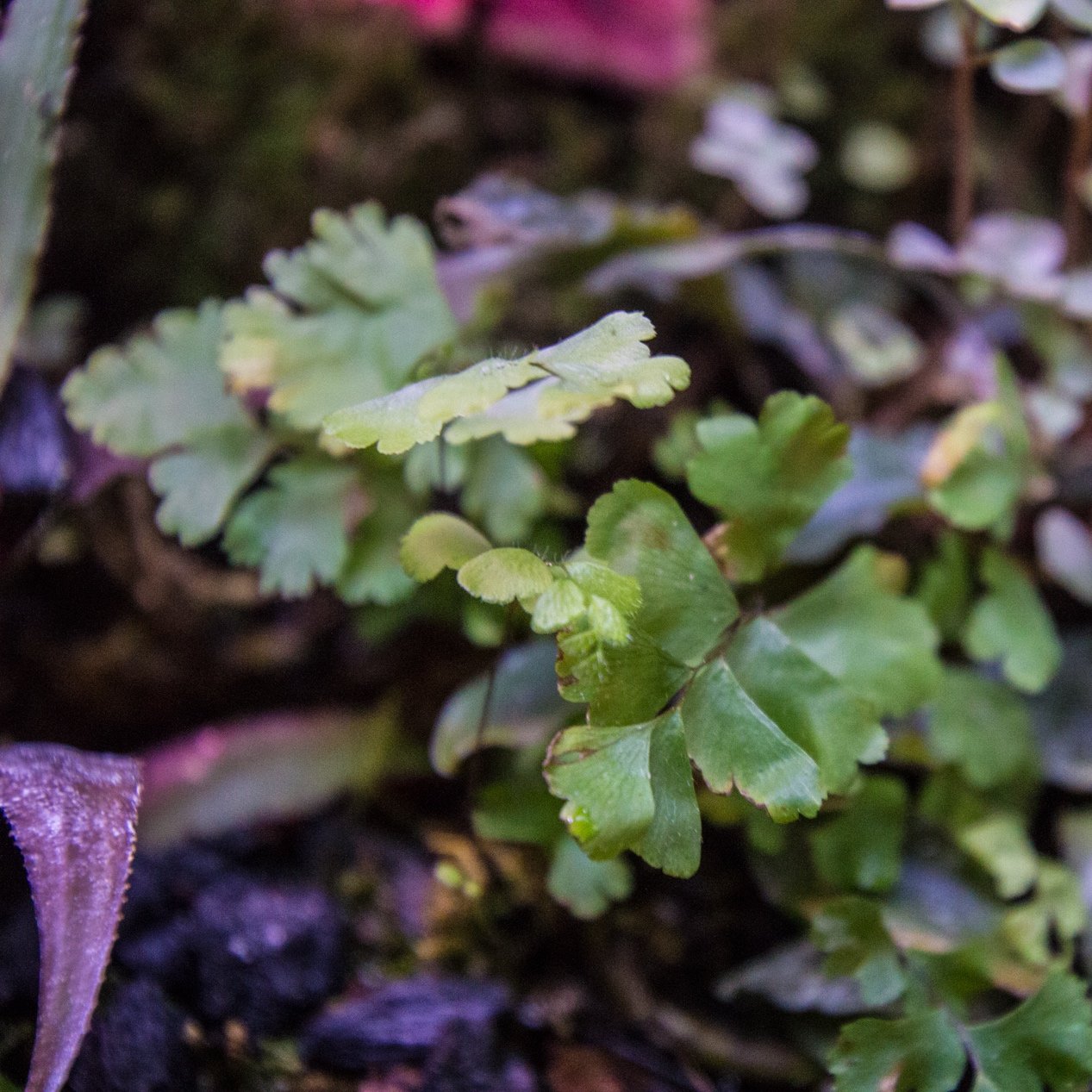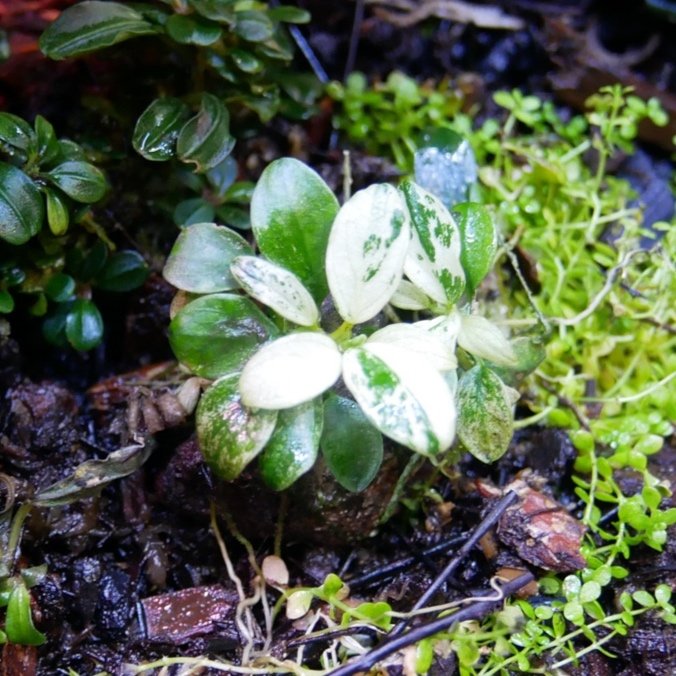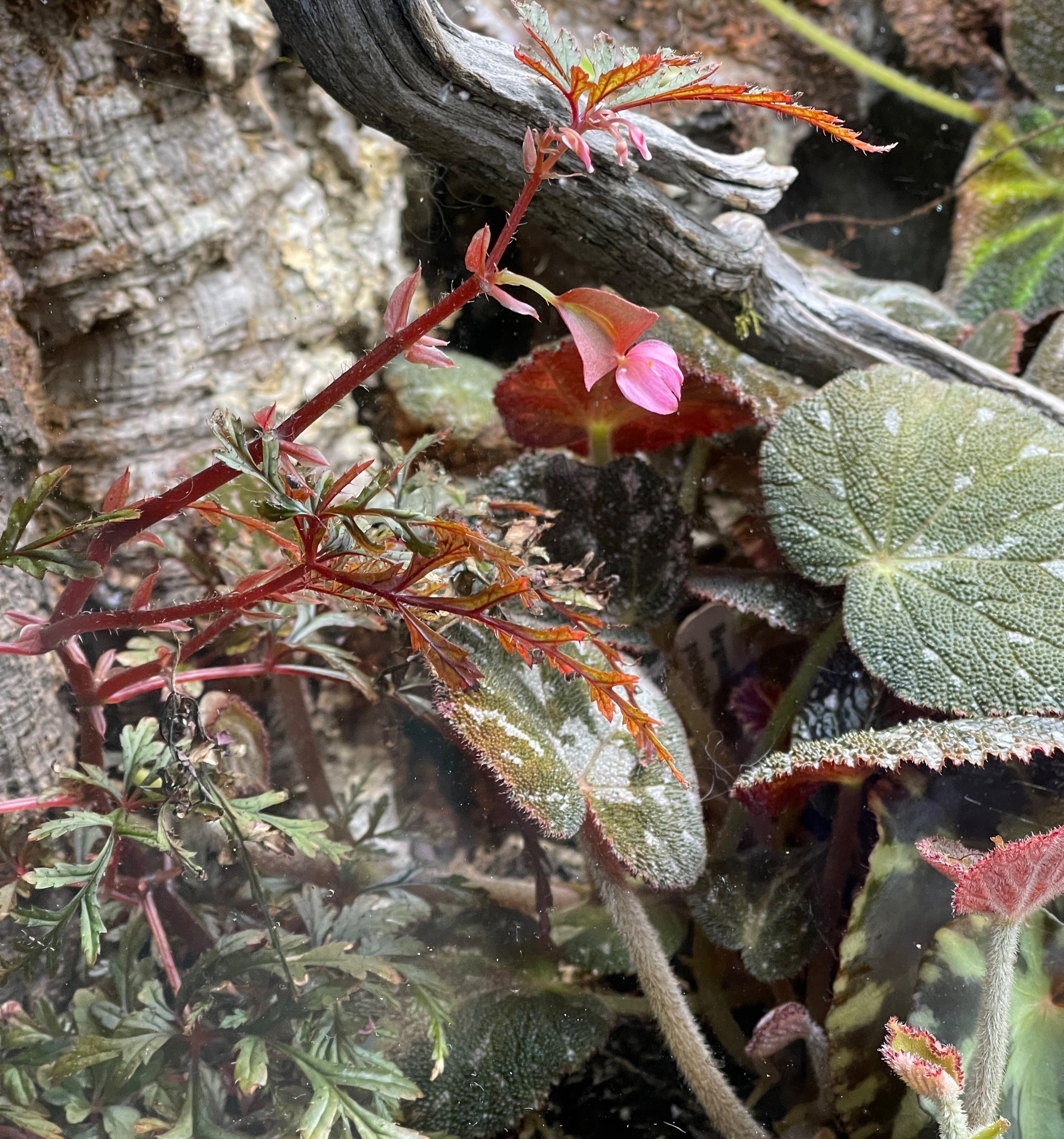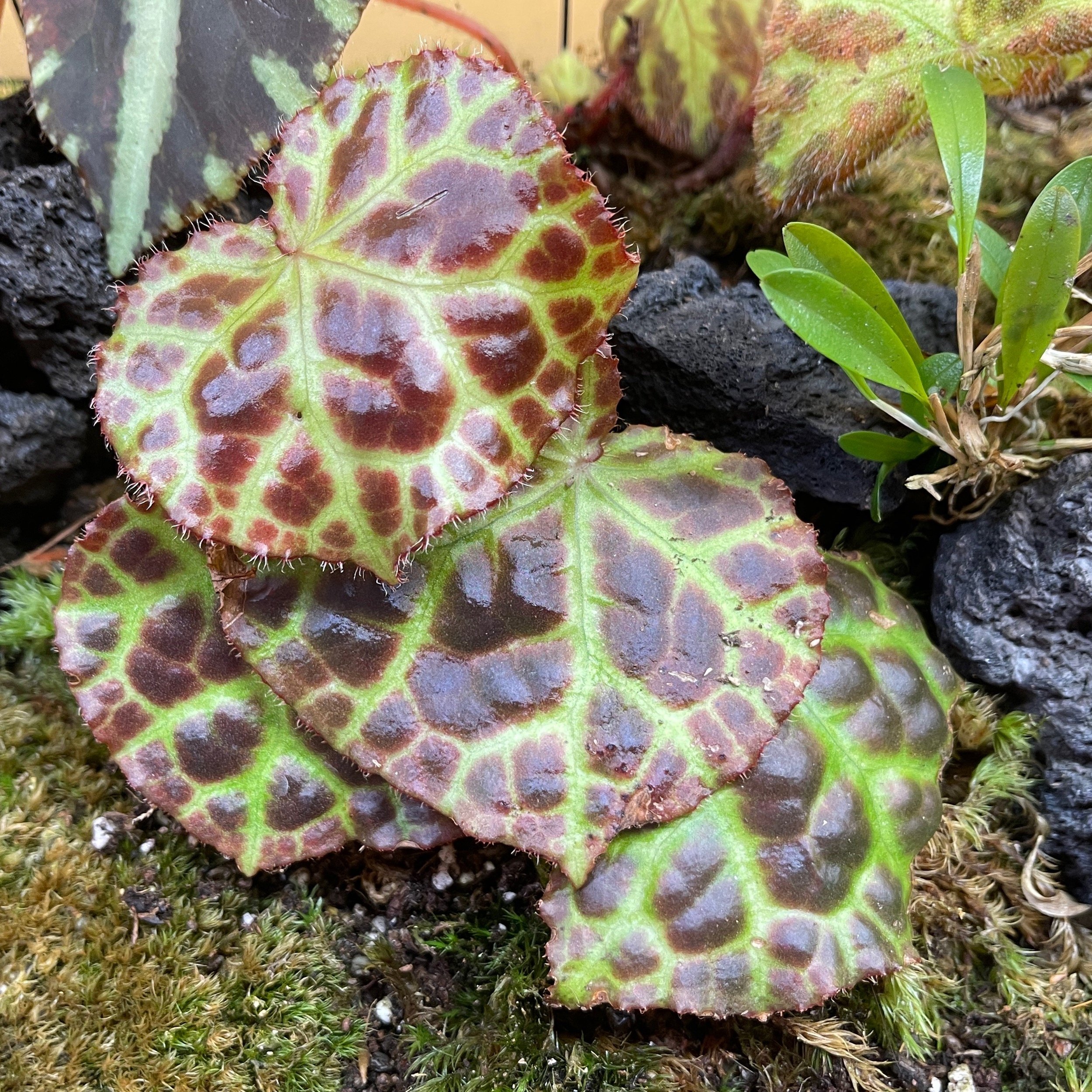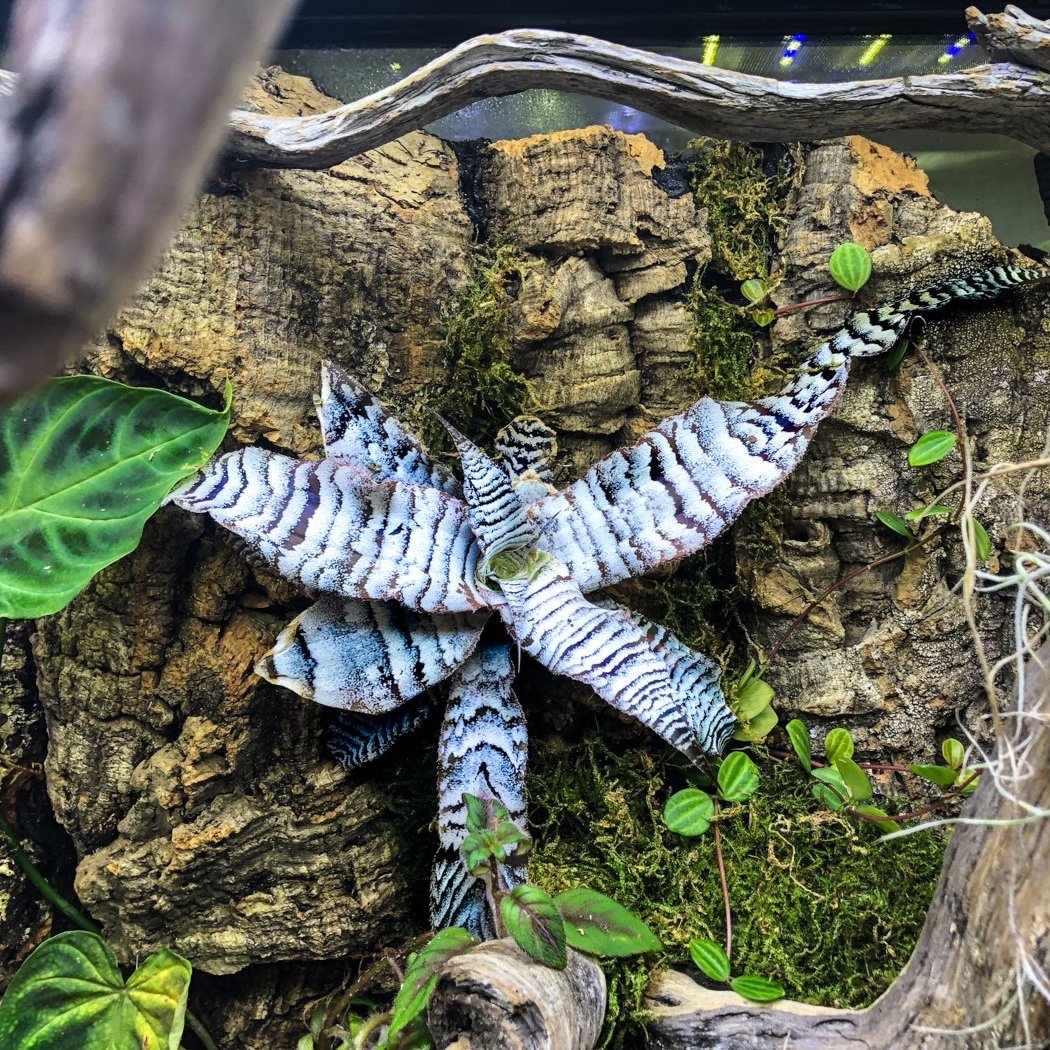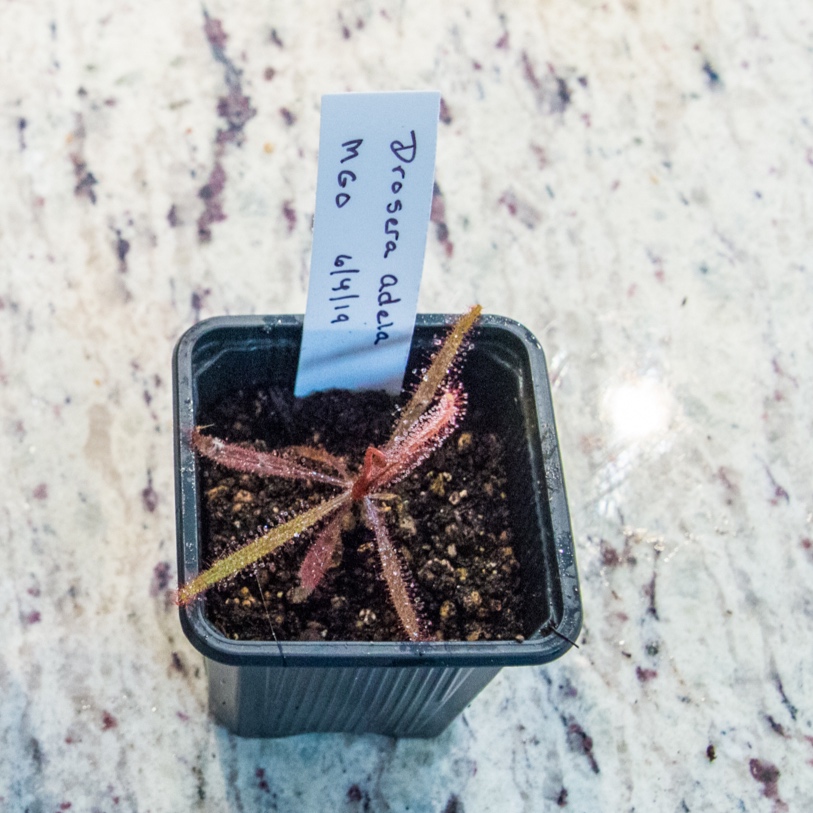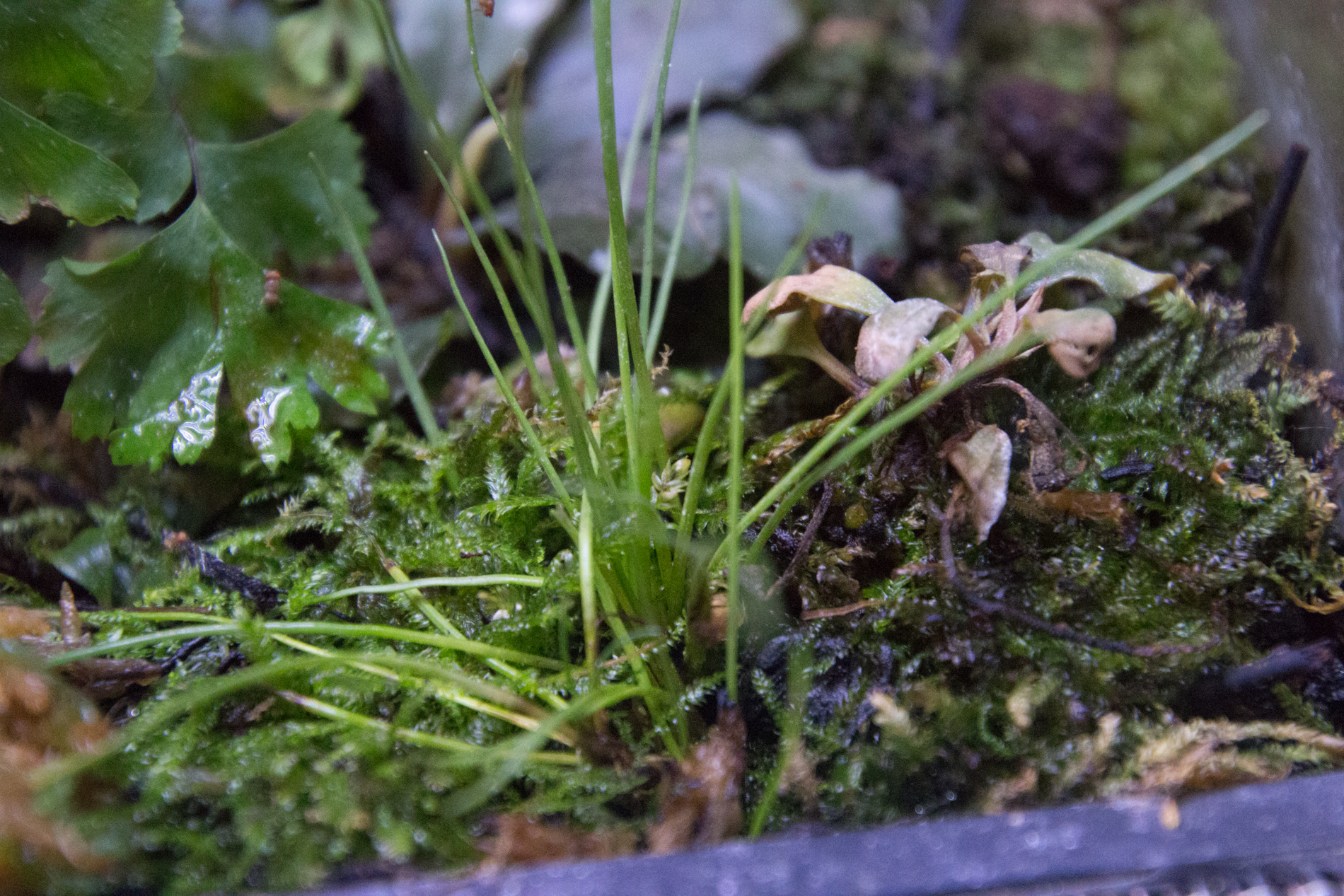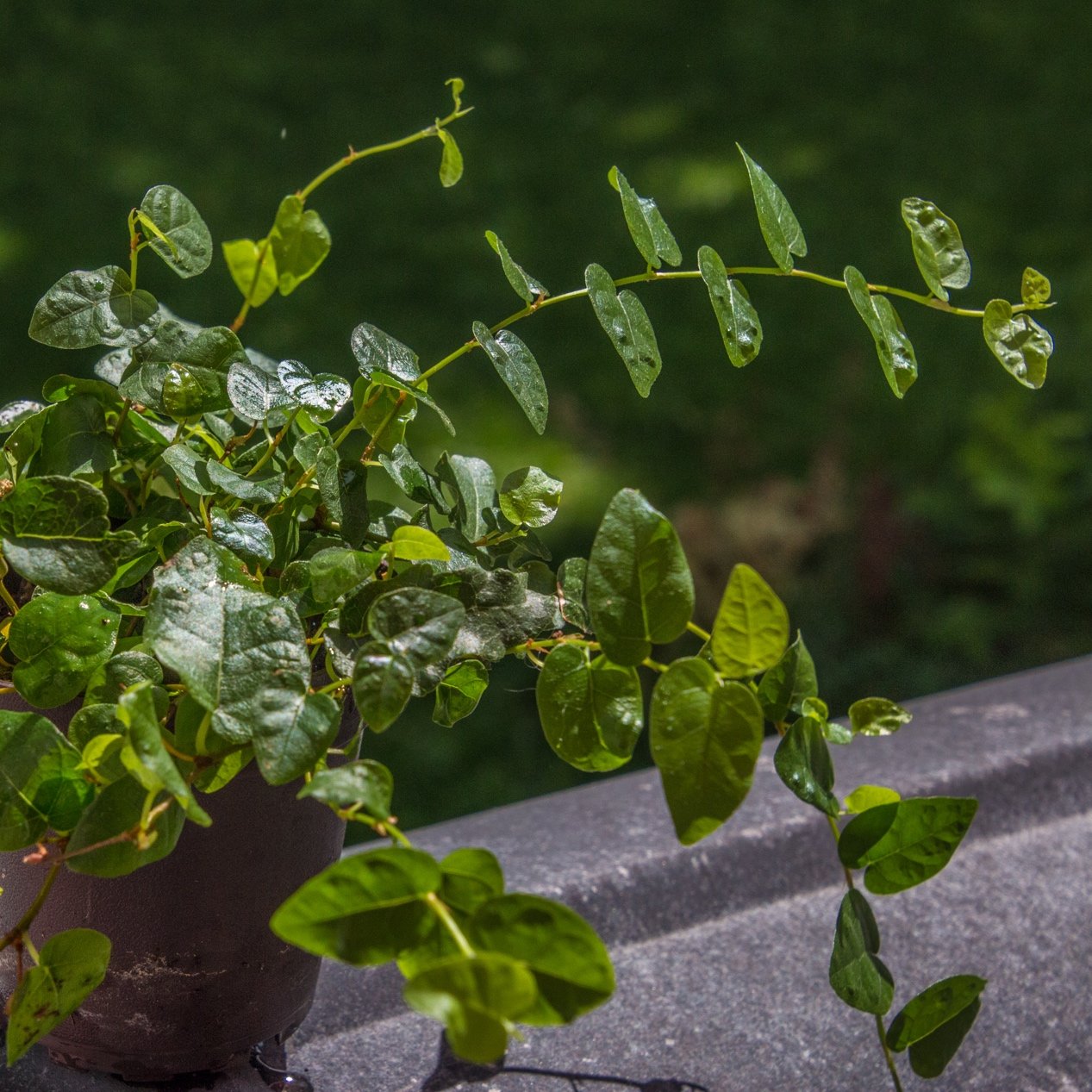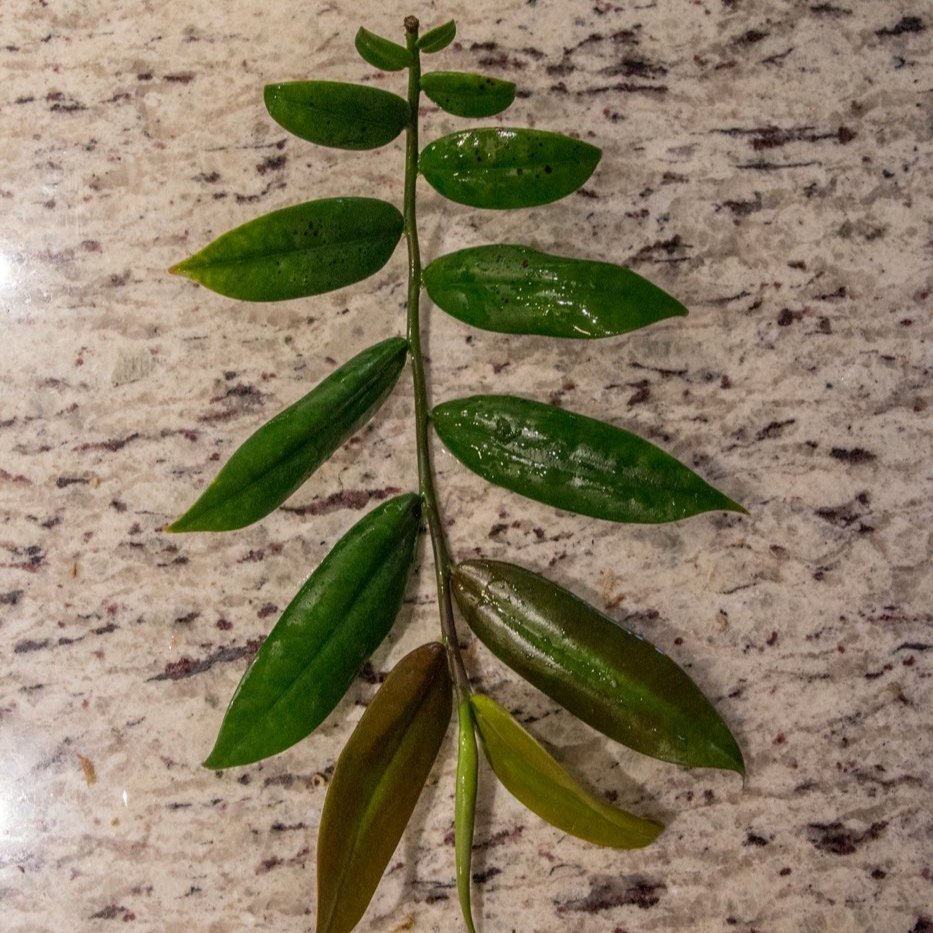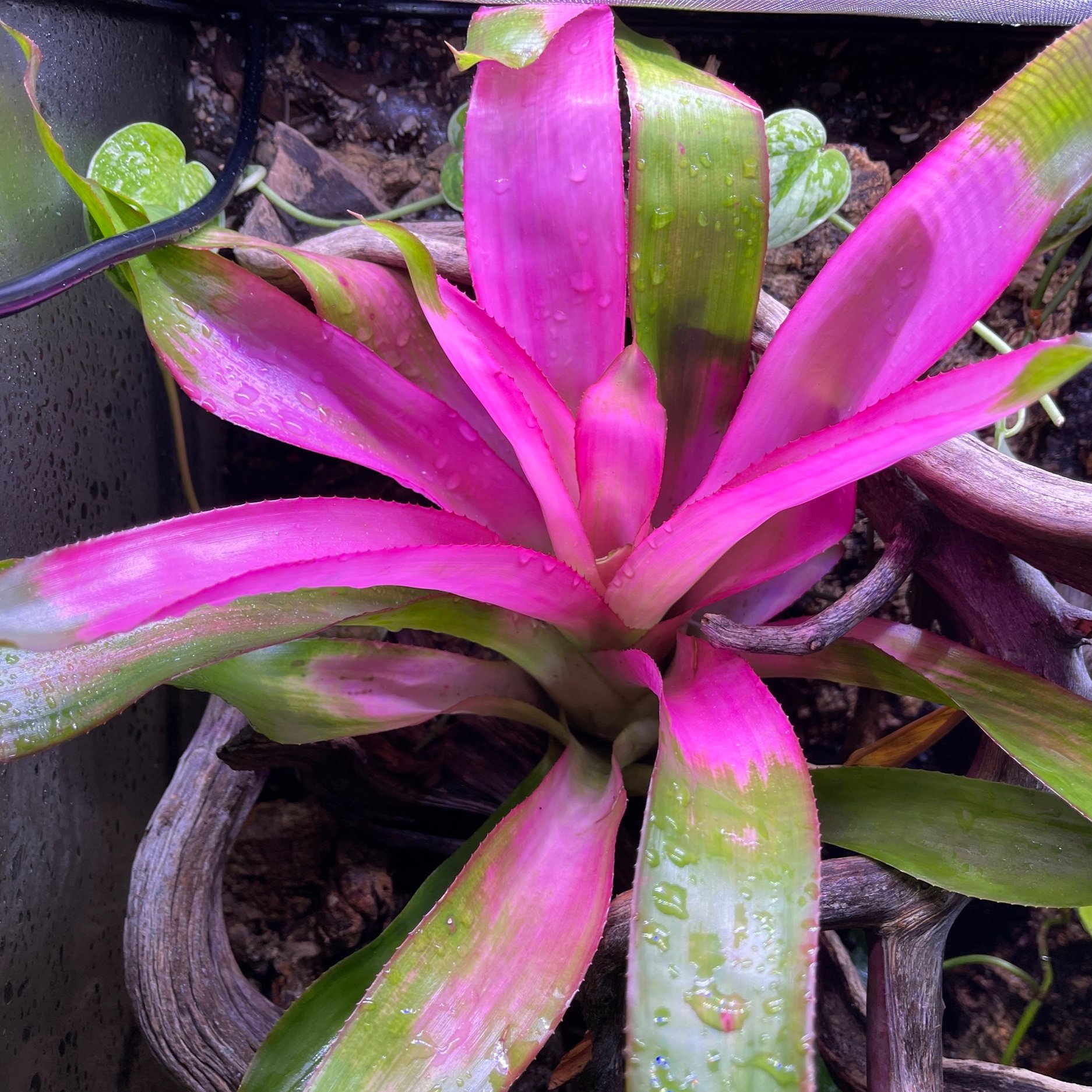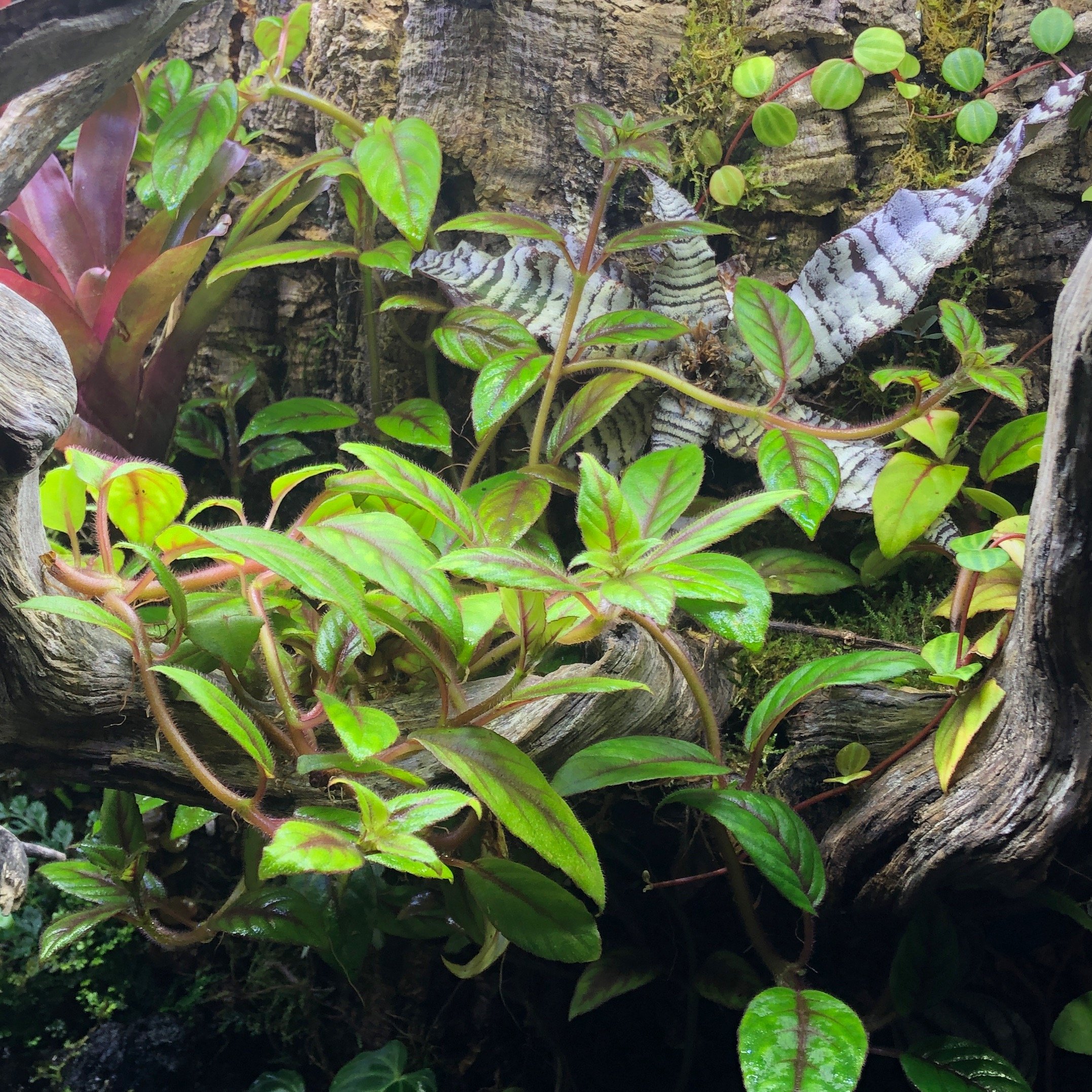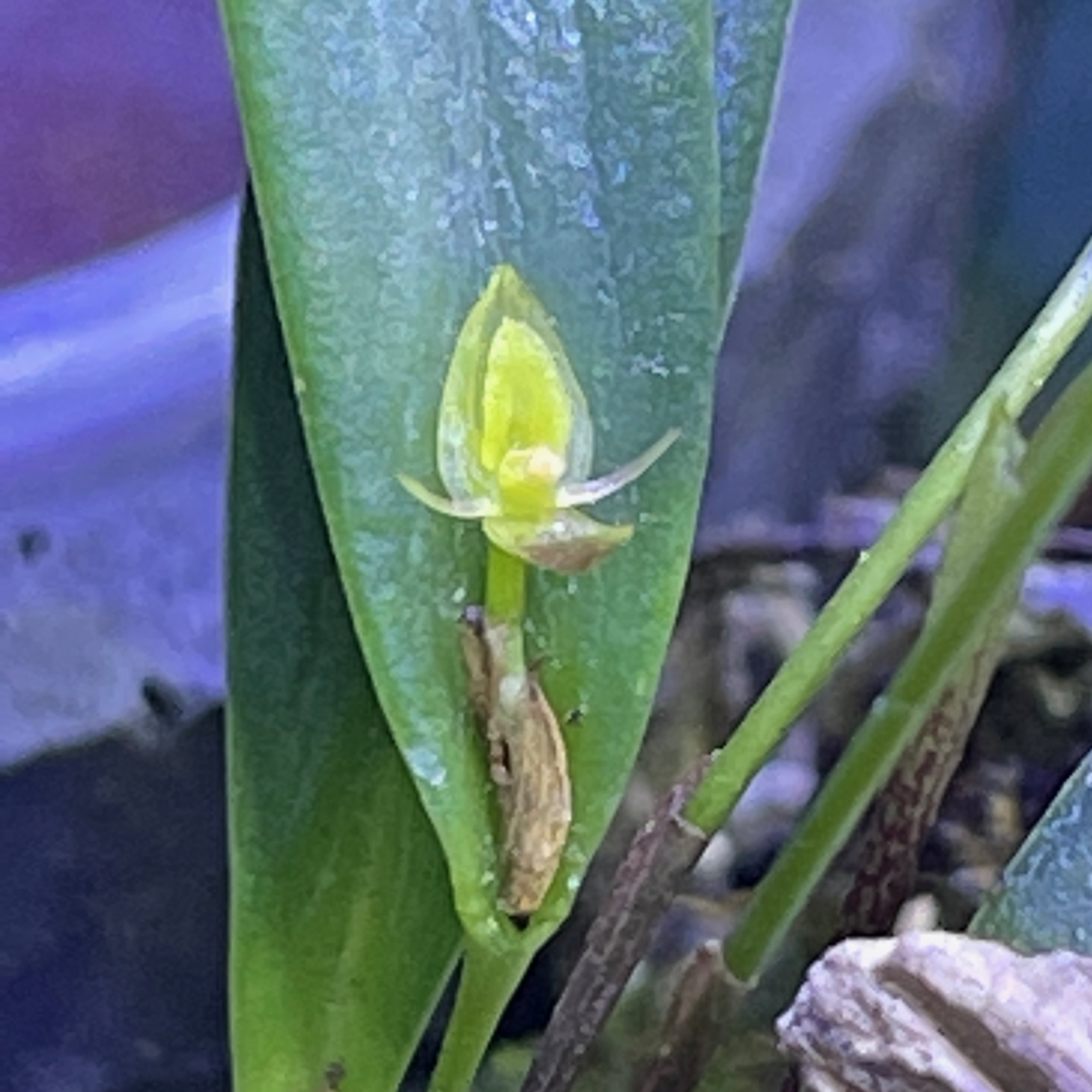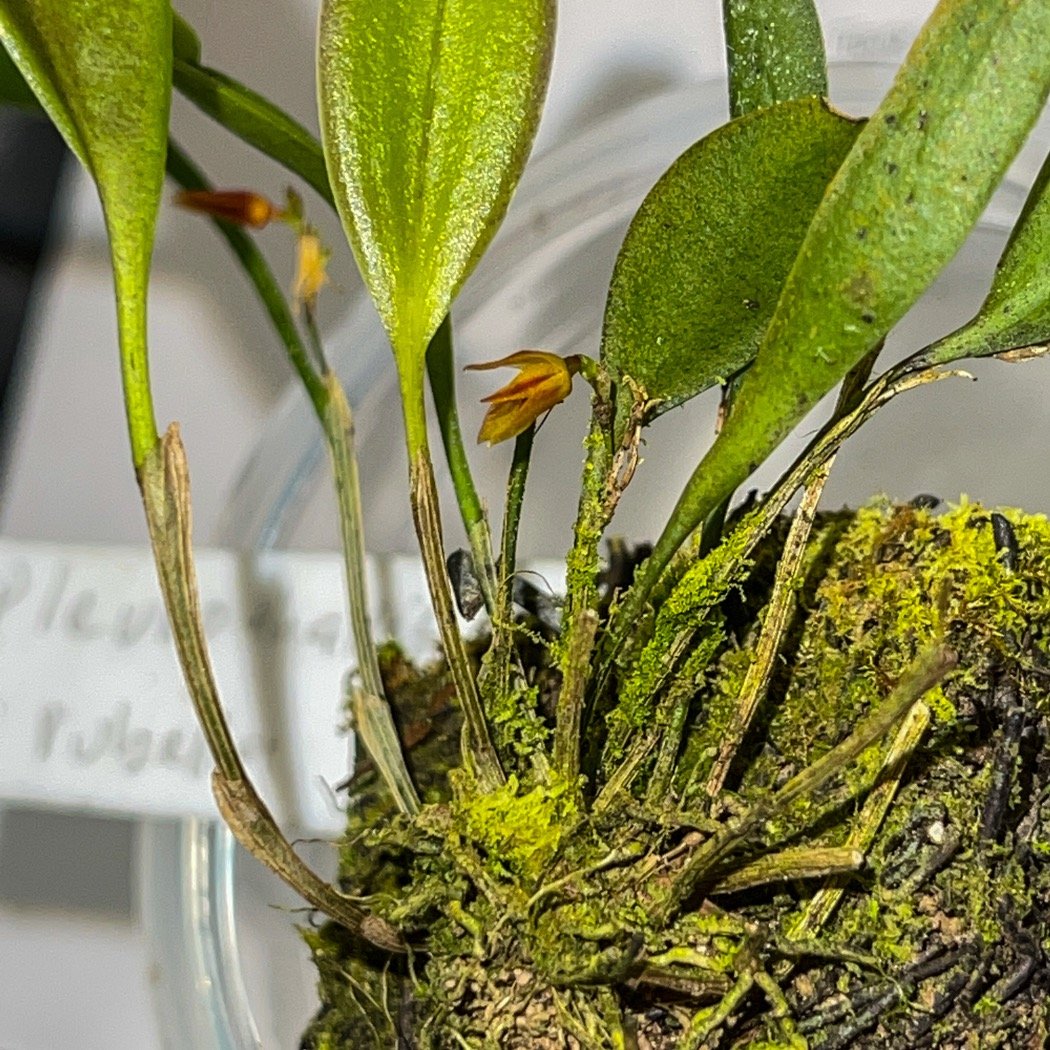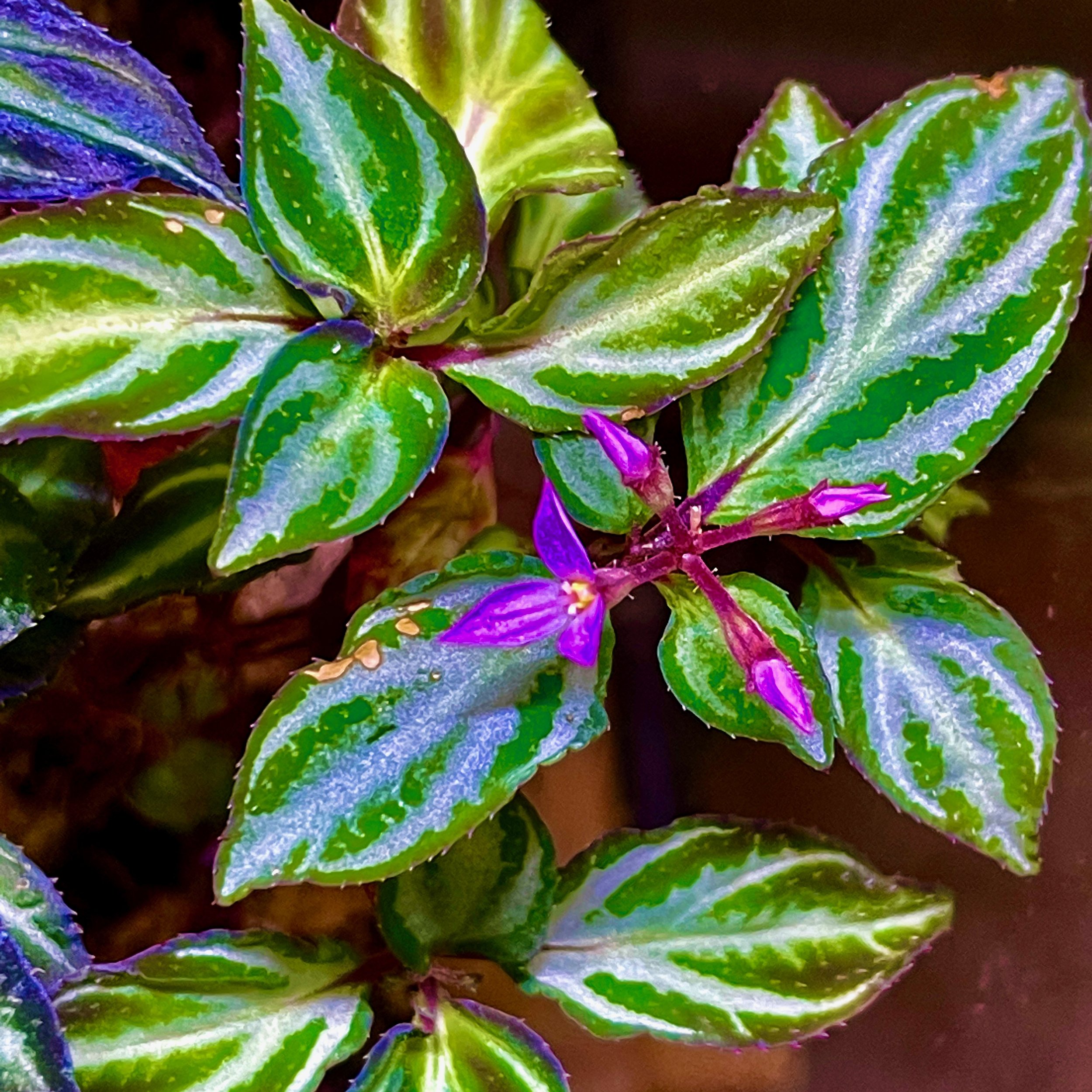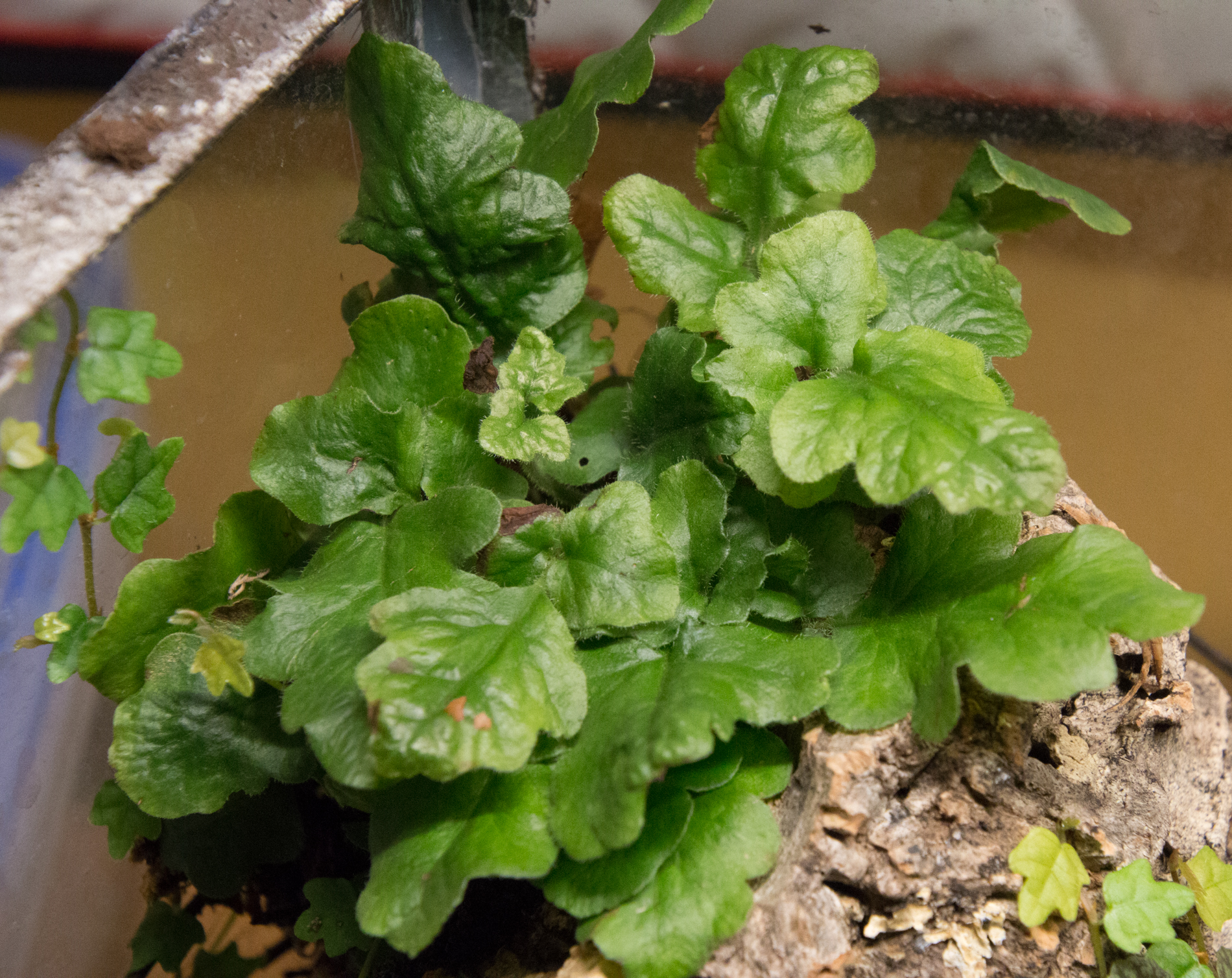This is the list of plants that I am currently maintaining in vivariums or (in the case of aquatic plants) in emersed culture. I have not included any submersed aquarium plants in this list and this is by no means an exhaustive list of what can be kept in a vivarium or terrarium. You will see that for the most part, I favor smaller, slower growing species because my enclosures are smaller. They are also, largely, moisture-loving plants.
Over time, I will try to add photos of the plants and my experiences with them in various conditions. As I add more information it will become possible to click on the plant name to access that and/or more photos. This list is very much a work in progress, and often ID’s have been based on information given to me by the people who grew the plants, although I have tried to verify them where possible. So please feel free to contact me if you see an error.
Acorus 'chacosekisho'
I know very little about this specific plant, except that it came to me with this name. Acorus in general are marsh plants that enjoy good light, and this one follows right along with that.
Actiniopteris australis
Common name - “Eyelash fern”
These are difficult little ferns in my experience. They need VERY high humidity, and they keel over and die if you look at them cross-eyed.
Adiantum x
There are many species of Maiden Hair Fern and they can do very well in vivariums, terrariums and paludariums. They often show up adventitiously in moss mixes. They can often be purchased in 2-3” pots at garden centers and the plants can be further divided into small sections for use in terrariums, where they will grow slowly for quite a long time. I like them better in small terrariums, because their root systems can become invasive in a vivarium as the plant grows.
Common name - “Lipstick Plant”
Very fast growing, and can be used in terrariums as well as vivariums. Will need regular trimming. Can also be used as a house plant.
Aeschynanthus longicaulis 'Black Pagoda'
Alocasia 'Black Velvet'
This is a relatively large plant, though a smaller Alocasia. I like this in moderately humid vivariums, such as those for New Caledonian Geckos. They do very well in this humidity level, and their leaves are tough enough to handle the weight of the geckos as well.
Alocasia 'Dragon Scale'
This is a relatively large plant, though a smaller Alocasia. I like this in moderately humid vivariums, such as those for New Caledonian Geckos. They do very well in this humidity level, and their leaves are tough enough to handle the weight of the geckos as well.
Alsobia dianthiflora
This little Gesneriad works well in terrariums and vivariums. It reproduces prolifically by runner, and if given enough light, will produce small white flowers.
Anoectochilus albolineatus
One of the jewel orchids. It likes a humid environment, but not consistently wet substrate. Does best in a terrarium designed for this type of plant. Too much light will bleach the foliage.
Anoectochilus “Charlotte’s Web”
A jewel orchid hybrid, this one is a bit easier than some of the species. It likes a humid environment, but not consistently wet substrate. Does best in a terrarium designed for this type of plant. Too much light will bleach the foliage.
Anoectochilus formosanus
One of the jewel orchids, this species is from Taiwan. It likes a humid environment, but not consistently wet substrate. Does best in a terrarium designed for this type of plant. Too much light will bleach the foliage. This is not a particularly easy species; I’d start with Macodes petola or Anoectochilus “Charlotte’s Web” before trying this one.
Anthurium scandens (gracile)
This vining plant might seem like a bit of a “plain Jane”, but its prolific air roots add a lot of interest to a large vivarium, and the flowers, when they show up, are interesting as well!
Anubias barteri ‘Coffeefolia’
A mainstay of the aquarium world, all of the the Anubias genus also do great in humid terrariums and vivariums.
Anubias barteri var. ‘Nana’ Petite
A mainstay of the aquarium world, all of the the Anubias genus also do great in humid terrariums and vivariums.
Anubias barteri ‘Nana’ Petite White
A mainstay of the aquarium world, all of the the Anubias genus also do great in humid terrariums and vivariums. Any white or variegated Anubias grow more slowly and are more delicate than the normal green versions, but they do grown more quickly and are more robust when grown emersed!
Anubias hastifolia
A mainstay of the aquarium world, all of the Anubias genus also do great in humid terrariums and vivariums.
Barbosella hiftzii
This is a REALLY tiny orchid. It seems to need fairly good light, and only moderate humidity for me. Blooms only intermittently.
Begonia amphioxus
This trendy Begonia was very expensive even a year ago, but tissue culture has brought the price way down and made it much more widely available as well. It can be a tick finicky while settling into new conditions, but once established, it is a solid grower as long as humidity is high, and flowers almost continuously.
Begonia baik
I killed this one. Would love to figure out how to grow it!
Begonia bipinnatifida
Begonia burkilii “Silver form”
This seems to be a relatively hardy Begonia species for my. There are several forms of B. burkilii available. The species is from India.
Begonia ‘Buttercup’
This seems to be a cultivar of B. prismatocarpa with leaves about 1 1/2 times the size of the the species. The flowers are also a bit larger. Otherwise, they are very similar.
Begonia cleopatrae
This is one of my favorite species begonias for terrariums or not-too-humid vivariums. It is not fussy, the leaves are stunning, and the flowers are pretty too! It is native to Palawan Island in the Philippines. I have read that is also works well as a house plant, though it grows slower under those conditions.
Begonia conchifolia
This Begonia is sometimes confused with Pilea peperomioides. But it is a moderate sized, free blooming, humidity loving Begonia, all of which make it a very good candidate for the terrarium or vivarium!
Begonia dodsoni
Most of the Gobenia Section Begonias are pretty similar. I think this is probably the most common.
Begonia elaeagnifolia
This little trailing Begonia is native to West Africa, from Cameroon to the Congo, and requires high humidity. As such, it is a wonderful option for the back wall of a vivarium, where it will settle in and bloom quite freely.
Begonia foliosa var. foliosa
Begonia glabra 'Bronze'
I haven’t had this one for all that long, but it seems quite trouble-free under terrarium conditions.
Begonia ‘Kit Kat’
This is a small cultivar that I’ve been growing for years in dart frog viv. It takes any amount of humidity without trouble. The leaves are pretty, though the flowers aren’t much to talk about.
Begonia klemmei
Begonia longiciliata 'Sizemoreae'
This is a good sized, easy to grow Begonia. I does well in a vivarium or terrarium, but I suspect it would also do well as a house plant. It is not fussy!
Begonia loranthoides sp. rhopalocarpa
This is a very different Begonia, from Cameroon. It has stiff, woody, trailing stems and tough, shiny elongated leaves.my experience with it has been the it is as tough as it looks. I suspect that it is probably not a good candidate for a very wet vivarium, but for the moderate to less humid vivarium or as a house plant, it is a fun and easy Begonia to work with.
Begonia luzonensis
This started very slowly for me, but once it got settled, it has done very well. Seems to like more light than some.
Begonia sp. ‘maldonado’
Another Gobenia Sect. Begonia. This one can get really aggressive in a dart frog type environment… to the point that some froggers rip it all out. In smaller terrariums, it can be controlled more easily.
Begonia manaus
Begonia maurandiae 'Blue'
Of the Gobenia sect. Begonias I’ve worked with, this one is, by far my favorite! It is not QUITE as aggressive as B. maldonado, and if it is grown under not-too-bright light, has the most beautiful blue cast to the foliage!
Begonia polliloensis
This Begonia with its finely divided leaves can be very useful in humid vivariums and terrariums with reasonable air flow. Interestingly, not only does the leaf color change (become redder) with higher light, but the flowers turn from white to pink!
Begonia prismatocarpa
This little Begonia is a prolific bloomer and does great even in very low light places deep in the bottom of humid dart frog vivariums.
Begonia pustulata
Begonia raja
This is another beautiful, relatively easy grower under a range of terrarium conditions.
Begonia “Raspberry Splash'‘
A typical Rex hybrid. It does fine as a house plant or in a Wardian Case. Probably too large for most terrariums.
Begonia ‘Regal Minuet’
My very favorite Rex hybrid. It is a medium size, with beautiful leaves. It tolerates even high humidity and regular spraying in dart frog vivariums, and blooms profusely and continuously with pretty pink flowers.
Begonia soli-mutata
The name means that it changes with the sun, and the color of the leave do change! It is equally at home in the terrarium, Wardian Case or as at a house plant. It has lovely sprays of small white flowers to go along with the beautiful leaves too.
Begonia sutherlandii 'Saunders Legacy'
Begonia ‘Sweet Pea’
Similar to Kit Kat, this is a nice, adaptable little Rex cultivar for vivarium use.
Begonia thelmae
This is a great small scrambling Begonia species for vivariums and terrariums. It needs a fair amount of humidity.
Begonia turrialbae
Another good species for the terrarium/vivarium. I haven’t killed it! I’ve actually grown it well enough that I’ve been able to spread it between several different vivariums.
Begonia variabilis
I love this one… and haven’t really learned how to grow it well.
Biophytum sensitivum
This is a fun plant that, as its name implies, is sensitive to touch; closing up when touched. When it blooms, it shoots seed around the enclosure, so you will find baby plants growing up all over the place. Once you buy one, you will have them forever!
Bolbitis heudelotii
A wonderful aquarium plant, B. heudelotti can also be used in very humid vivariums. It does best in a paludarium, where it can grow out of the water, or on the edge of a waterfall. But it can also be established in a humid vivarium if you are patient and persistent.
Bolbitis heteroclita var. cuspidata
This tiny little fern can be fussy in the wrong conditions. But give it what it needs and it grows very well. It needs very high humidity and a shady position; probably not surprising for a waterfall plant. I have it growing on the edge of waterfalls in two different paludariums, where it spreads beautifully.
Bucephalandra kishii
“skeleton king”
There are many Bucephalandra types and species that are available through the aquarium trade. I will add more in the future. Many of them do well in humid vivariums and terrariums. Please ONLY purchase Bucephalandra that have been tissue cultured or grown by another hobbyist. Most of the plants currently offered for sale as “farmed” are being taken from the wild in an unsustainable manner.
Bulbophytum intersitum
Calvoa sessiliflora
This plant is said to have similar growth requirements to Sonerila Sp. But I have found it to be more sensitive and likely to drop leaves.
Ceropegia woodii
“String of Hearts”
Not a plant for a very humid terrarium, but can be useful in a terrarium or vivarium of more moderate humiditidy, such as those for New Caledonian Geckos. Also does well in Wardian Cases.
Ceropegia woodii
“String of Spades”
Not a plant for a very humid terrarium, but can be useful in a terrarium or vivarium of more moderate humiditidy, such as those for New Caledonian Geckos. Also does well in Wardian Cases.
Cirrhopetalum (Bulbophyllum) farreri
Cirrhopetalum (Bulbophylum) taiwanese
Cissus amazonicus
Not as flashy as C. discolor, but still a lovely and worthwhile vivarium plant. Not apparent in this photo is the pretty wine red back side of the leaves. One thing that is, perhaps, a little nicer, is that it doesn’t grow quite as fast!
Cisus discolor
An absolutely gorgeous plant, sometimes erroneously called “Begonia vine” due to the brightly colored leaves. (It is not related to Begonias!) It is too large for small terrariums, and even in larger vivariums, it can be weedy. But oh what a lovely weed!
Codonanthe carnosa
Codonanthe digna
This small leafed plant works in terrariums or vivariums, and even in fairly moderate light will delight you with pink-tinged white flowers on a fairly regular basis!
Crepidomanes minutum
This is a very pretty, tiny filmy fern. It absolutely MUST have very high humidity, kept on damp sphagnum or in very wet conditions in the vivarium/terrarium. At the same time, it is so small and delicate that it is easily outgrown by other plants. So take care that it has the space it needs. It is happiest in shady areas. Various forms of Crepidomanes minutum can be found widely in the tropical Pacific area.
Cryptanthus x
There are quite a few different Cryptanthus cultivars available. Also known as “ground stars”, they are a small Bromeliad that normally does grow on the ground. However, they canal's be pinned to the background in smaller vivariums to take the place of Neoregelias in builds where those might be too large. They need bright light to keep their bright pink colors.
Cryptanthus 'Absolute Zero'
This is a stunning black and white cultivar, as long as it gets strong light. (otherwise it fades to greenish) This shows how Cryptanthus can be pinned to the background and do very nicely. This happens to be quite a large cultivar.
Davallia trichomanoides
One of the rabbit’s foot ferns, this fern is a native to Malaysia. It can get rather large, up to about 17” tall, but is frequently available in 2-3” pots at the big box stores these can be further divided into very small pieces that work very well in terrariums, where they grow slowly and are useful fro quite a long time with regular pruning. This is not a plant I would use in a larger vivarium, because the roots of a larger plant are very strong and can undermine the background of the build.
Deinostigma tamiana
(Was Chirita)
One of my favorite small Gesneriads, this little gem flowers profusely and regularly, and reproduces both by offset and by setting seed.
Diastema aff. hispidum
Dischidia ruscifolia
Dossinia marmorata
Sorry for the poor photo, but it makes the point. This little jewel orchid has been really hard for me!
Drosera adela
Drosera capensis
Drosera spatulata
Eleocharis radicans
Epipremnum aureum 'Global Green'
Episcia ‘Chocolate Velvet’
Episcias make lovely vivariums plants, though they can grow too fast for some people’s tastes. They have a wonderful range of both foliage and flower colors, so there is something for everyone! They can also be kept as house plants, but are a bit more demanding this way.
Episcia cupreata
Episcias make lovely vivariums plants, though they can grow too fast for some people’s tastes. They have a wonderful range of both foliage and flower colors, so there is something for everyone! They can also be kept as house plants, but are a bit more demanding this way.
Episcia ‘Lilacina’
Episcias make lovely vivariums plants, though they can grow too fast for some people’s tastes. They have a wonderful range of both foliage and flower colors, so there is something for everyone! They can also be kept as house plants, but are a bit more demanding this way.
Episcia ‘Silver Dust’
Episcias make lovely vivariums plants, though they can grow too fast for some people’s tastes. They have a wonderful range of both foliage and flower colors, so there is something for everyone! They can also be kept as house plants, but are a bit more demanding this way. (‘Silver Dust’ is my personal favorite!)
Equisetum bogotense
Ficus pumila
This is an extremely fast growing little vine. …To the point of being invasive. Many vivarium keepers will not use it for this reason. It just takes over. However, If you want something that will fill in fast, this plant will do the trick!
Ficus pumila ‘Snowflake’
This cultivar is a little slower growing than its plainer sibling, making it a very useful terrarium plant, though most vivarium people still avoid it.
Ficus punctata (?)
Ficus thunbergii
(often sold incorrectly as F. pumila ‘Quercifolia’) “oak leaf creeping fig”
My favorite of the small Ficus sp., it CAN be a bit invasive, and I’m not sure I would introduce it to a large, long-term vivarium for that reason. However, it is such a pretty little plant that I do use it frequently in smaller vivariums and terrariums, where it is quite easy to manage, and such a beautiful little thing!
Ficus vaccinioides
Ficus vilosa
This larger leafed, hairy Ficus is welcome in any humid, larger vivarium. It is harder to establish than the smaller Ficus species, but worth the effort!
Fittonia albivenis var. argyoneura
Fittonia albivenis 'Ruby Red'
“Nerve plant”
These fast growing “stem” plants are a staple of the terrarium world for a “pop of color”. They come in a number of different color varieties and can be a wonderful way to add a bit of contrast. They are fast growing, a nd need more light than many other plants. They need to be picked back often to stay nice and bushy.
Fittonia albivenis ‘Super Red’
Nerve plant
These fast growing “stem” plants are a staple of the terrarium world for a “pop of color”. They come in a number of different color varieties and can be a wonderful way to add a bit of contrast. They are fast growing, a nd need more light than many other plants. They need to be picked back often to stay nice and bushy.
Geogenanthus poeppigi
Seersucker Plant
Geogenanthus poeppigi is native to Amazonia, including the lowlands of Peru and western Brazil. This is not an inexpensive plant, and not common. But if you come across it, pick it up. It grows very well in the low to moderate light terrarium or vivarium.
Goeppertia ornata
Was “Calathea”
One of the few Goeppertia or Calathea sp. that stay reasonably sized enough to use in a vivarium at least for a while!
Haerella odorata
Hatiora (Rhipsalis) salicorniodies
This is a tiny little jungle cactus! It is a great vivarium, terrarium plant and also works as a house plant.
Hemigraphis alternata
Common name: Purple waffle
This plant is often offered as an inexpensive terrarium plant. It does offer nice color and texture.
Hupertzia sp.
Hygrophila pinnatifida
This is a cross-over plant from the aquarium world but makes a lovely addition to the humid terrarium as long as its feet can be kept wet enough.
Hypoestes phyllostachya
Common name: Polka dot plant
This pretty little plant comes in both pink and white polka dots. It needs quite bright light, and will require regular trimming to prevent it from getting leggy. But with those caveats in mind, it is a useful terrarium plant.
Lemmaphyllum microphyllum
This tiny little fern s a favorite of mine in vivariums. It does wonderfully in very low light areas. It is a slow grower, but very reliable.
Lepanthes telipogoniflora
Leptochilus pteropus '“Needle Leaf”
needle leaf Java fern
The genus name was changed from Microsorum. Java fern works well in very humid vivariums. It can work in terrariums, but only if they are designed specifically to be very humid environments. SO very often, it makes sense to design the entire terrarium around them and other aquatic plants.
Leucobrym glaucum
Common name - Cushion Moss
This is a wonderful native moss that grows very well in the humid terrarium or vivarium if planted properly. Please collect responsibly and legally, or buy from responsible sources. This moss is prone to disease (it seems to be fungal) even in the wild. I have found that the best way to avoid problems is to immediately treat any new pieces with a copper sulfate based anti-fungal spray or dip before use or storage. This moss can be propagated quite easily from clippings if you are patient.
Liverwort (NOID)
Occasionally you can find terrestrial liverworts offered for sale. Other times, you can find them growing adventitiously in the pots of plants purchased from greenhouses. Or you may find them growing in a greenhouse, and WITH PERMISSION, ask to take some. These often can do beautifully in a humid vivarium or terrarium, giving a different texture than moss to the low areas.
Ludisia discolor
This is one of the easiest jewel orchids to keep, either as a terrarium or home plant. And don’t discount the flowers on this one! They are lovely too when they show up!
Macodes petola
Other than Ludisia, Macodes petola is probably the next easiest jewel, but this one definitely does better in the protection of a terrarium or vivarium.
Marcgravia sp. ‘Bronze’
Marcgravia sp. are confusing, and few are correctly identified by species. All of them are enjoyed in our vivariums in the juvenile form, so it is not surprising that they don’t flower, making identifying them better more difficult. For this reason, I have just listed the names they have beens sold to me under. There are several “brown ones” sold under a variety of names. I have no confidence that they are actually different plants.
Marcgravia sp. ‘Dark Brown’
Marcgravia sp. are confusing, and few are correctly identified by species. All of them are enjoyed in our vivariums in the juvenile form, so it is not surprising that they don’t flower, making identifying them better more difficult. For this reason, I have just listed the names they have beens sold to me under. There are several “brown ones” sold under a variety of names. I have no confidence that they are actually different plants.
Marcgravia sp. ‘Ecuador’
Marcgravia sp. are confusing, and few are correctly identified by species. All of them are enjoyed in our vivariums in the juvenile form, so it is not surprising that they don’t flower, making identifying them better more difficult. For this reason, I have just listed the names they have beens sold to me under.
Marcgravia sp. “El Coca” (mature)
This is one Marcgravia that is well known, and in this case, I was sold a section of adult, or at least semi-adult foliage. I have had a very difficult time trying to get this to revert to the more attractive juvenile foliage! Marcgravia sp. are confusing, and few are correctly identified by species. All of them are enjoyed in our vivariums in the juvenile form, so it is not surprising that they don’t flower, making identifying them better more difficult. For this reason, I have just listed the names they have beens sold to me under.
Marcgravia sp. "El Coca" Ecuador
This is the juvenile foliage form. Marcgravia sp. are confusing, and few are correctly identified by species. All of them are enjoyed in our vivariums in the juvenile form, so it is not surprising that they don’t flower, making identifying them better more difficult. For this reason, I have just listed the names they have beens sold to me under.
Marcgravia sp. ‘Peru’
Marcgravia sp. are confusing, and few are correctly identified by species. All of them are enjoyed in our vivariums in the juvenile form, so it is not surprising that they don’t flower, making identifying them better more difficult. For this reason, I have just listed the names they have beens sold to me under.
Marcgravia "Puerto Rico"
Marcgravia sp. are confusing, and few are correctly identified by species. All of them are enjoyed in our vivariums in the juvenile form, so it is not surprising that they don’t flower, making identifying them better more difficult. For this reason, I have just listed the names they have beens sold to me under.
Marcgravia “St. Lucia Island”
Marcgravia sp. are confusing, and few are correctly identified by species. All of them are enjoyed in our vivariums in the juvenile form, so it is not surprising that they don’t flower, making identifying them better more difficult. For this reason, I have just listed the names they have beens sold to me under.
Marcgravia sintinesii
Marcgravia sp. are confusing, and few are correctly identified by species. All of them are enjoyed in our vivariums in the juvenile form, so it is not surprising that they don’t flower, making identifying them better more difficult. For this reason, I have just listed the names they have beens sold to me under. M. sintinesii is one of the FEW that we know is correctly ID’d.
Marcgravia sp. ’Suriname’
Marcgravia sp. are confusing, and few are correctly identified by species. All of them are enjoyed in our vivariums in the juvenile form, so it is not surprising that they don’t flower, making identifying them better more difficult. For this reason, I have just listed the names they have beens sold to me under.
Marcgravia umbellata “Red” (Ecuador)
Marcgravia sp. are confusing, and few are correctly identified by species. All of them are enjoyed in our vivariums in the juvenile form, so it is not surprising that they don’t flower, making identifying them better more difficult. For this reason, I have just listed the names they have beens sold to me under.
Masdevallia auropupurea
Masdevallia floribunda
Masdevallia nidifica
This lovely little orchid is a terrific, profuse bloomer, and reblooms regularly in vivarium conditions.
Micranthemum tweedei
An aquarium regular that also does very well as a vivarium plant as long as you can keep it well enough hydrated.
“Mini Rose Moss”
Keep it nice and moist and it will grow beautifully!
Monolena primulaeflora “Red”
These plants are beautiful and get quite large. So they aren’t for every build. But they are beautiful, and they seed freely. So once you get them going, you will have plenty!
Muehlenbeckia complexa
Common name: Fairy Vine or Wire Vine
This is a plant that I love in the right place! It is a fast grower, so make sure you want it where you put it. On the other hand, it is easy enough to cut back, and it doesn't strangle things the way Ficus does. It always stays light and airy. It also gets lovely little white flowers on it from time to time.
Muehlenbeckia complexa (Variegated)
Like its plain green form, it’s a lovely plant and fun to work with. Like most variegated forms, it is slower growing, which might be appreciated!
Nautilocalyx sp
Neoregelia "Blushing Tiger x Puntatissima"
Neoregelia hybrids are available in almost an infinite variety. For vivarium use, most people want the smaller ones. But even among those, there are many varieties. All the ones listed here are great in a mid-sized vivarium or larger. They need good light to maintain their red colors so do not allow them to become shaded. While they need a humid environment, they also need good ventilation. They reproduce by producing offset “pups’ that can be removed and used elsewhere.
Neoregelia 'Cotton Candy'
Neoregelia hybrids are available in almost an infinite variety. “Cotton Candy is the largest variety I keep, but it is so spectacular with it’s bright pink color that it is worth pride of place in the right vivarium! For vivarium use, most people want the smaller ones. But even among those, there are many varieties. All the ones listed here are great in a mid-sized vivarium or larger. They need good light to maintain their red colors so do not allow them to become shaded. While they need a humid environment, they also need good ventilation. They reproduce by producing offset “pups’ that can be removed and used elsewhere.
Neoregelia ‘Lilyput x Pheasant’
Neoregelia hybrids are available in almost an infinite variety. For vivarium use, most people want the smaller ones. But even among those, there are many varieties. You can be pretty sure that if ‘Lilyput’ is one of the parents, it will be a small one! All the ones listed here are great in a mid-sized vivarium or larger. They need good light to maintain their red colors so do not allow them to become shaded. While they need a humid environment, they also need good ventilation. They reproduce by producing offset “pups’ that can be removed and used elsewhere.
Neoregelia 'Easter Egg'
Neoregelia hybrids are available in almost an infinite variety. For vivarium use, most people want the smaller ones. But even among those, there are many varieties. All the ones listed here are great in a mid-sized vivarium or larger. They need good light to maintain their red colors so do not allow them to become shaded. While they need a humid environment, they also need good ventilation. They reproduce by producing offset “pups’ that can be removed and used elsewhere.
Neoregelia 'Fireball'
Neoregelia hybrids are available in almost an infinite variety. For vivarium use, most people want the smaller ones. But even among those, there are many varieties. N. ‘Fireball’ is undoubtedly, the best known and most popular of the vivarium forms. It stays small, pups prolifically, and in good light stays bright red. While I do like them, they have been used so often, I urge you to investigate some of the many other options as well!
Neoregelia ‘Lilyput x Pheasant’
Neoregelia hybrids are available in almost an infinite variety. For vivarium use, most people want the smaller ones. But even among those, there are many varieties. All the ones listed here are great in a mid-sized vivarium or larger. They need good light to maintain their red colors so do not allow them to become shaded. While they need a humid environment, they also need good ventilation. They reproduce by producing offset “pups’ that can be removed and used elsewhere.
Neoregelia 'Mini Skirt'
Neoregelia hybrids are available in almost an infinite variety. For vivarium use, most people want the smaller ones. But even among those, there are many varieties. To me, this one is even prettier than ‘Fireball’, if not quite as prolific. All the varietiess listed here are great in a mid-sized vivarium or larger. They need good light to maintain their red colors so do not allow them to become shaded. While they need a humid environment, they also need good ventilation. They reproduce by producing offset “pups’ that can be removed and used elsewhere.
Neoregelia 'Mojo'
Neoregelia hybrids are available in almost an infinite variety. For vivarium use, most people want the smaller ones. But even among those, there are many varieties. All the ones listed here are great in a mid-sized vivarium or larger. This stunning variety is a favorite of mine for the larger vivarium, with it’s narrow leaves and striking patterning. They need good light to maintain their red colors so do not allow them to become shaded. While they need a humid environment, they also need good ventilation. They reproduce by producing offset “pups’ that can be removed and used elsewhere.
Neoregelia ‘Skotak's Matilde’
Neoregelia hybrids are available in almost an infinite variety. For vivarium use, most people want the smaller ones. But even among those, there are many varieties. All the ones listed here are great in a mid-sized vivarium or larger. They need good light to maintain their red colors so do not allow them to become shaded. While they need a humid environment, they also need good ventilation. They reproduce by producing offset “pups’ that can be removed and used elsewhere.
Neoregelia 'Skotak Mirage'
Neoregelia hybrids are available in almost an infinite variety. For vivarium use, most people want the smaller ones. But even among those, there are many varieties. All the ones listed here are great in a mid-sized vivarium or larger. They need good light to maintain their red colors so do not allow them to become shaded. While they need a humid environment, they also need good ventilation. They reproduce by producing offset “pups’ that can be removed and used elsewhere.
Neoregelia 'Skotak's Unregistered'
Neoregelia hybrids are available in almost an infinite variety. For vivarium use, most people want the smaller ones. But even among those, there are many varieties. All the ones listed here are great in a mid-sized vivarium or larger. They need good light to maintain their red colors so do not allow them to become shaded. While they need a humid environment, they also need good ventilation. They reproduce by producing offset “pups’ that can be removed and used elsewhere.
Neoregelia ‘Wild Tiger Goode'
Neoregelia hybrids are available in almost an infinite variety. For vivarium use, most people want the smaller ones. But even among those, there are many varieties. All the ones listed here are great in a mid-sized vivarium or larger. They need good light to maintain their red colors so do not allow them to become shaded. While they need a humid environment, they also need good ventilation. They reproduce by producing offset “pups’ that can be removed and used elsewhere.They occasionally bloom in the vivarium, and this often signals the eventual death of that specific plant, though its offsets will continue on.
Nephrolepis exaltata 'Fluffy Ruffles'
This miniature Boston Fern cultivar tops out at 12”, making it a great candidate for terrariums and vivariums. Like most ferns, it thrives in high humidity. You can often buy these ferns in tiny, “miniature plant” pots, and divide them into even smaller sections. divided and used in terrariums in this way, they grow quite slowly, and can be used successfully in even small terrariums for a fairly long time.
Paradrymonia campostyla "Suriname"
This vining Gesneriad is hardy as nails, and fast-growing enough to be a bit annoying for more experienced folks. But this makes it a wonderful beginners’ vivarium plant, though it might be a bit large and fast growing for most smaller terrariums. In good conditions, with enough light, it will also produce pretty, small white flowers.
Peperomia angulata
P. angular can be used as a house plant, terrarium plant or vivarium plant. So clearly it is not fussy. It vivariums, I find that it does best pinned to the wall with it’s roots or cut end wrapped in sphagnum and allowed to find its own way. Spray it regularly until it is well-rooted, but make sure that it also has good ventilation. Then it is bullet-proof!
Peperomia caperata 'Schumi'
P. caperata comes in a number of different cultivars and colors. This dark red one is a lovely accent plant for mid sized terrariums.
Peperomia cf. eburnea
This pretty little trailer is not as common as some, but is not expensive when you can find it. It is a pretty little plant and useful in either terrariums or the right place in a vivarium. It does nee higher humidity to thrive.
Peperomia emarginella "small leaf"
The smallest peperomia, this little vining species is extremely prolific as long as it has moderate light and good humidity. In fact, if it has a fault, it is that it can over grow other plants if you don’t cut it out from time to time. But tis tiny foliage is useful in places where nothing larger will do.
Peperomia fagerlindii
The deep green, heart shaped leaves of P. fagerlindii on its deep purple vine makes it very attractive, I the terrarium or vivarium. I find that this one also flowers readily for me, and although the flowers aren’t particularly showy, flowers are always fun!
Peperomia guttalata
This little trailing Peperomia definitely requires a humid environment, and is easily crowded out by larger plants. But it’s dainty sets of three leaves at each node make it a welcome and different looking little plant, worthy of a spot in the terrarium or smaller vivarium. Native to Ecuador
Peperomia aff jamesoniana
This is another small creeping Peperomia This one with small but narrow lanceolate leaves, green on top, maroon underneath with a cream line. It is also another one that can be easily crowded out by faster growing, larger plants. It is native from Panama to Ecuador
Peperomia sp. ‘Lago’
This is a stunning small Peperomia that grows into small rosette type clump with some trimming. The color is stunning; the color in this phot is accurate, showing the lovely blue-green color with the pale blue center stripe. The back side of the leaves are maroon. It is native to Lago Ecuador.
Peperomia ‘Pepper Spot’
Peperomia ‘Pepper Spot’ is a small trailing Peperomia that can be used as a house plant, it terrariums or in the vivarium. It does appreciate humidity, skeet the in mind if using it as a house plant.
Peperomia prostrata
The common name for P. prostrate is “string of turtles, and it is a popular house plant. But I think it grows much better in the vivarium or terrarium, placed on the wall, in good humidity, and allowed to creep around on its own.
Peperomia puteolata
This is a beautiful Peperomia native to Columbia, that I have used in terrariums a number of times. It is probably useful in vivariums also, though I have not used it that way. It has rather stiff stems, and grows upright for a while before starting to trail. It can also be grown as a house plant quite easily, so it does not REQUIRE high humidity,
Peperomia rubella
P. rubella is a tiny red-stemmed Peperomia with pretty white-patterned green leaves. It is a lovely addition to the terrarium or to a spot in a vivarium where you can keep it from being crowded out. It can be grown as a house plant, but in my experience, it does better in a humid environment. This plant is native to Jamaica.
Peperomia serpens
Peperomia serpens is a very useful vining plant in the vivarium and terrarium. it is vigorous without being invasive, easy to grow, and pretty. It is widespread in both South and Central America.
Peperomia taroriana "White Stripe"
I don’t know much about the background of this tiny little viner. But it needs a humid environment and is easily outcompeted, so make sure it has the room it needs to thrive and show the delicate white lines on its leaves.
Peperomia ‘Tingo Maria’
My very favorite of the vining Peperomias, P. ‘Tingo Maria’ has lovely, velvety leaves with beautiful reddish patterning on the top side and red bottoms which match the stems as well. The plant gets its name from The Tingo Maria are of Peru and as might be expected from its natural environment, it is a humidity lover that does best in vivariums and large
Peperomia trinervis
This stunning Peperomia is trailing in form, and quite adaptable. It can be used in terrariums or vivariums, but can also be hardened off and used as a houseplant. It is a native of Ecuador.
Peperomia turboensis
This plant might be confused with the more commonly seen “watermelon Peperomia”, Peperomia argyreia. But it has more silver, the leaves are more pointed, and it tends to vine more than grow in a clump. It also prefers higher humidity than the more common P. argyreia, making it a great candidate for larger vivariums, as seen here. This Peperomia is native to Columbia.
Peperomia verticillata, Red Log
This fairly common Peperomia is wide spread in South and Central America. It is a bright, pretty plant that works well in terrariums and also as a house plant. I have not used it in a vivarium.
Philodendron ‘Burle Marx Fantasy’
This is a plant that is more often used as a house plant, but as long as you have a large enough vivarium, there is no reason not to use it there! It’s pretty, silvery leaves are lovely there!
Philodendron hederaceum var. hederaceum
(Philodendron “Micans”) I LOVE this Philodendron, whether it is used as a house plant or in a vivarium! While it is fast growing, and will need regular whacking back in a humid vivarium, its beauty makes it worth the effort. It is also useful in vivariums meant for mid-sized herps that require humid conditions, because it is robust enough to withstand the animal climbing over it. Native to the tropical parts of Central and South America
Philodendron (NOID) from Colombia (collected by CW)
Philodendron verrucosum
This stunning Philodendron is known as a temperamental, pest-prone house plant. You can use VERY young cuttings for a very short while in some vivariums, where it will grow happily and healthy. Unfortunately, it will outgrow the space quickly in all but the largest! It is native to Ecuador.
Philodendron verrucosum 'Mini'
The “mini” version is more useful, but even this one needs a lot of space. It will work well in a viv the size of the largest ExoTerras, though. You trade off more manageable size for a bit less striking patterning on the leaves.
Philodendron ‘Wend-Imbe’
This is a cross between Philodendron Wendlandii and Philodendron Imbe. It is a nice, compact Philodendron with leaves that top out at only about 6” long and 1” wide. The plant forms tight clumps that works well in smaller and mid-sized vivariums and terrariums. It also grows more slowly than many!
Pilea sp.Ecuador
This species from Ecuador is very sturdy and easy to grow, but has a reasonable growth rate, so is not likely to take over. Can be used either in vivariums or miss sized terrariums
Pilea libanensis ‘Aquamarine’
While you can use this plant in the vivarium, it is probably more popular as a terrarium plant, where it is very pretty and grows well. The best way to use it is to just insert tip cuttings into your terrarium and let them root in place. Because of the small leaf size it works very well in even quite small terrariums.
Pilea pubescens liebmannii 'Silver Cloud'
This Pile has slightly larger leaves but makes a lovely terrarium plant or vivarium plant. It will need regular topping to keep it bushy and pref=vent it from becoming leggy.
Pilea spruceana
An inexpensive, stunningly beautiful and readily available Pilea that is another good option for terrariums and vivariums as long as you keep on top of pruning to keep it tight and bushy.
Pinguicula x gigantea
While many carnivorous plants are not great candidates for the terrarium or vivarium, Pinguicula can do very well in the humid vivarium or terrarium, with a proper substrate for them, and they will happily rid your build of fungus gnats!
Piper crocatum
From what I have been able to determine, even though this and Piper ornatum are being sold as the same plant, they are not. P. crocatum is from S. America, while P. ornatum is endemic to Indonesia. P. crocatum is supposed to have red undersides to the leaves while those of P. ornatum should be silver/white. However, I have also been told that P. crocatum generally has narrower leaves than P. ornatum. As can be seen from the photo, my specimen of P. crocatum, which has very red undersides to the leaves, also has very round leaves. So it does seem that leaf shape can be variable, which probably adds to the confusion between these two plants..
Pleopeltis percussa
This is a small, pretty creeping fern on a fuzzy white “foot” of a rhizome. It is not an expensive plant, but not always easy to find. It does well in a humid environment in moderate light conditions. It is a slow grower, so don’t let it get crowded out. P. percuss is wide spread in Central and South America.
Pleurothalis allenii
This is one of my best growing little orchids. It seems to never stop flowering as long as it gets plenty of light, good air flow and high humidity. It is native to Panama.
Pleurothallis costaricensis
From Costa Rica, this little orchid is one of the easier vivarium orchids, and blooms several times a year under good conditions. It likes moderate light, high humidity and good air flow, but is not as fussy as many other miniature orchids.
Pleurothalis grobyi
From Central and South America, This tiny orchid is another one that does well in humid tropical vivarium conditions with good light, high humidity and good air movement.
Pleurothallis rubella
From the cloud forests of the Andes, this orchid requires high humidity, making it a perfect candidate for the humid vivarium with good light and good air circulation.
Pogostemon deccanensis
Best known as an aquarium plant, Pogostemon deccanensis is a worthy vivarium, terrarium and Wabi Kusa pant, and will reward you with beautiful purple flowers, if given adequate light.
Polyscias fruticosa
(Ming Aralia) Are often offered for “Fairy Gardens”, so find their way into terrariums as well. They can grow large, so can only be used at their smallest sizes, but with that in mind, they can be pretty for a while, They also do not like very wet conditions, so are not candidates for very humid builds. However, in the right container, they can be attractive and useful.
Procris pulchra
(was Pellionia)
This beautiful creeping vine is tremendously useful in both terrariums and vivariums. It is fast growing, so won’t be to everyone’s tastes, but what is petty to some people makes it e=a delight to others who are getting started!
Procris repens
(was Pellionia)
This is the “big brother” of Procris pulchra. It is even larger and faster growing, but every bit as useful a plant. This one is also sometimes found in hanging baskets in garden centers.
Pyrrosia nummularifolia
This tiny fern is from Papua New Guinea. It is a very slow grower, but does well in both humid terrariums and vivariums.
Restrepia lansburghi
From Venezuela and Peru, R. lansburghi is another regular bloomer for me, with almost constant flowers in the top part of my paludarium, with bright light. As you can see in the photo, in stronger light, like many orchids, the leaves turn deep maroon.
Restrepia muscifera
From the rainforests of Southern Mexico, Columbia and a few spots in Peru, this little orchid grows in mats. The flowers grow singly, against the leaves, and the name, “muscifera”, is a Latin word referring to the flower looking like it has a fly on it.
Rhaphidophora cryptantha
This lovely shingler is a great plant for the back wall of any humid vivarium. It is a slow grower; slower than Marcgravia, in my experience, but very pretty and different mixed in with your other shinglers. It tends to be an expensive plant, but I think it’s well worth it!
Rhipsalis sp.
Riccardia chamedryfolia
Ruellia makoyana
Scaphosepalum dodsoni
Selaginella erythropus 'Sanguinea'
Selaginella martensii 'Watsoniana’ (variegated)
Selaginella (Misc.)
Selaginella kraussiana
Stelis argentata
Sinningia "Freckles"
Sinningia 'Prudence Risley'
Solanum evolvulifolium
Solanum sp. ‘Ecuador’
Solanum uleanum
Sonerila (Dark spotted)
Sonerila aff. herterostamon
Sonerila sp. Neon Lights
Sonerila cantonensis Stapf. sp. Vietnam
Strobilanthes dyerianus
Persian Shield
Syngonium ‘Albo’
Syngonium rayii
Tectaria zeilanica
Also known as the “oak leaf fern”, this little fern is native to South East Asia. I have used it successfully in a number of terrariums and vivariums.
Tillandsia ionatha
e.
Tillandsia spp.
Woody fungi
Zootrphion sp.



